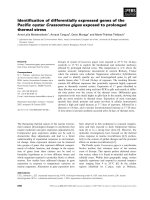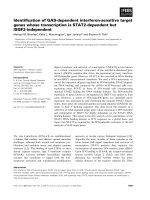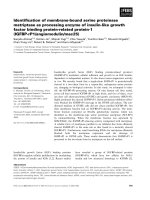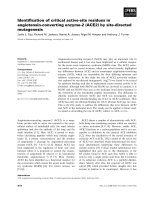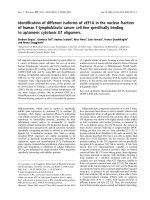Báo cáo toán học: "Classification of (p, q, n) dipoles on nonorientable surfaces" doc
Bạn đang xem bản rút gọn của tài liệu. Xem và tải ngay bản đầy đủ của tài liệu tại đây (92.26 KB, 6 trang )
Classification of (p, q, n)-dipoles on
nonorientable surfaces
∗
Yan Yang
Department of Mathematics
Tianjin University, Tianjin, P.R.China
Yanpei Liu
Department of Mathematics
Beijing Jiaotong University, Beijing, P.R.China
Submitted: May 4, 2009; Accepted: Jan 30, 2010; Published: Feb 8, 2010
Mathematics S ubject Classifications: 05C10, 05C30
Abstract
A type of rooted map called (p, q, n)-dipole, whose numbers on su rfaces have
some applications in string theory, are defined and the numbers of (p, q, n)-dipoles
on orientable surfaces of genus 1 and 2 are given by Visentin and Wieler (The
Electronic Journal of Combinatorics 14 (2007),#R12). In this paper, we study th e
classification of (p, q, n)-dipoles on nonorientable surfaces and obtain the numbers
of (p, q, n)-dipoles on the projective plane and Klein bottle.
1 Introduction
A surface is a compact 2-dimensional manifo ld without boundary. It can be represented
by a polygon of even edges in the plane whose edges are pairwise identified a nd directed
clockwise or counterclockwise. Such polygonal representations of surfaces can also be
written by words. For example, the sphere is written as O
0
= aa
−
where a
−
is identified
with the opposite direction of a on the boundary of the polygon. In general, O
p
=
p
i=1
a
i
b
i
a
−
i
b
−
i
and N
q
=
q
i=1
a
i
a
i
denote, respectively, an orientable surface o f genus p and a
nonorientable surface of genus q. Of course, N
1
, O
1
and N
2
are, respectively, the projective
plane, the torus and the Klein bottle. Every surface is homeomorphic to precisely one of
the surfaces O
p
(p 0), or N
q
(q 1) [2,5].
∗
Supported by NNSF of China under Grant No.10571013
the electronic journal of combinatorics 17 (2010), #N12 1
Let S be the collection of surfaces and let AB be a surface. The following topological
transformations and their inverses do not change the orientability and genus of a surface:
TT 1: Aaa
−
B ⇔ AB where a /∈ AB, TT 2: AabBab ⇔ AcBc where c /∈ AB and
TT 3: AB ⇔ (Aa)(a
−
B) where AB = ∅.
In fact, what is determined under these transformations is a topological equivalence ∼ on
S. Suppose A = a
1
a
2
· · · a
t
(t 1) is a word, then A
−
= a
−
t
· · · a
−
2
a
−
1
is called the inverse
of A. The following relations as shown in, e.g.,[2] can be deduced by using TT 1-3.
Relation 1: (AxByCx
−
Dy
−
) ∼ ((ADCB)(xyx
−
y
−
)),
Relation 2: (AxBx) ∼ ((AB
−
)(xx)),
Relation 3: (Axxyzy
−
z
−
) ∼ ((A)(xx)(yy) (zz)).
In TT 1-3 and Relation 1-3, A, B, C, and D are all linear orders of letters and permitted
to be empty. The parentheses stand for cyclic order and they are always omitted when
unnecessary to distinguish cyclic or linear order. The following two lemmas can both be
deduced by Relation 1-3.
Lemma 1.1[3] An orientable surface S is a surface of orientable genus 0 if and only if
there is no form as AxByCx
−
Dy
−
in it.
Lemma 1.2[9] Let S be a nonorientable surface, if there is a form as AxByCx
−
Dy
−
in S, then the genus of S will be not less than 3; if there is a form as AxByCx
−
Dy or
AxByCyDx in S, then the genus of S will be not less than 2.
A map is a 2-cell embedding of a graph on a surface. The enumeration of maps on sur-
faces has been developed and deepened by people, based on the initial works by W.T.Tutte
in the 1960s. The reader is referred to the monogr aph [4] for further background about
enumerative theory of maps.
The joint tree model of a graph embedding which was established in [2] by Liu, can be
used as a model for constructing an embedding of a graph on surfaces without repetition
in sense of topolo gical equivalence. Some works have been done based on the joint tree
model, such as [1,7,8,9] etc.
Given a spanning tree T of a graph G, for 1 i β, we split each cotree edge e
i
into
two semi-edges and label them by a
i
and a
ε
i
i
where ε
i
is a binary index, it can be +(always
omit) or −, and β is the number of cotree edges of G. The resulting graph consisting
of tree edges in T and 2β semi-edges is a tree, denote by
ˆ
T . A rotation at a vertex v,
denoted by σ
v
, is a cyclic permutation of edges incident with v. Let σ
G
=
v∈V (G)
σ
v
be
a rotation system of G.
The tree
ˆ
T with a choice o f index of each pair of semi-edges labelled by the same
letter and a rotation system of G is called a joint tree of G, denote by
ˆ
T
ε
σ
. By reading
these lettered semi-edges with indices of a
ˆ
T
ε
σ
in a fixed orientatio n (clockwise or counter-
clockwise), we can get an algebraic representation for a surface. It is a cyclic order of 2β
letters with indices. Such a surface is called an associate surface [3] of G. If two associate
surfaces of G have the same cyclic order with the same ε in their algebraic representations,
then we say that they are the same; otherwise, distinct. In fact, the edge e
i
whose two
semi-edges have the distinct indices i.e. a
i
and a
−
i
is the untwisted edge in the embedding;
the electronic journal of combinatorics 17 (2010), #N12 2
otherwise twisted.
From [3], there is a 1-to-1 correspondence between associate surfaces and embeddings
of a graph, hence the problem of determining the nonequivalent embeddings for a g raph
on a surface with given genus can be transformed into that of finding the number of
distinct associate surfaces in an equivalent class(up to g enus).
A type of rooted map called (p, q, n)-dipole is defined in [6]. Let M be a rooted map
with 2 vertices of degree n (with no loops) and o ne other distinguished edge e. If edge e is
the pth edge after the root edge in the rotation of the root vertex, but is the qth edge after
the root edge in the rotation of the nonroot vertex, then M is a (p, q, n)-dipole. Without
the distinguished edge e, the map is a rooted dip ole. The numbers of (p, q, n)-dipoles
on orientable surfaces of genus 1 and 2 are given by Visentin and Wieler in [6]. Their
interest in doing it comes out of an application to string theory. The reader is referred
to [6] for more detail about dipoles and (p, q, n)-dipoles. In this paper, the numbers of
(p, q, n)-dipoles on the nonorientable surfaces of genus 1 (projective plane) and 2 (Klein
bottle) are obtained, by the joint tree method.
2 The number of rooted dipoles on the projective
plane and Klein bottle
According to the jo int tree method, we can choose the rooted edge as the tree edge and
label the n − 1 cotree edges by a
1
, . . . , a
n−1
, then the associate surfaces o f rooted dipoles
with n edges are of the form (a
1
· · · a
n−1
A), in which |A| = n − 1.
Lemma 2.1[8] The numbers of the spheres, projective planes and Klein bottles in the
surface set T
n−1
1
= {a
1
a
2
· · · a
n−1
A
|A| = n − 1} are
g
0
(T
n−1
1
) = 1, ˜g
1
(T
n−1
1
) =
(n − 1)n
2
and ˜g
2
(T
n−1
1
) =
(n − 2)(n − 1)n
2
6
,
respectively.
From Lemma 2.1, the following two theorems follow.
Theorem 2.1 The number of rooted dipoles with n edges on the projective plane is
(n − 1)n
2
.
Theorem 2.2 The number of rooted dipoles with n edges on the Klein bottle is
(n − 2)(n − 1)n
2
6
.
the electronic journal of combinatorics 17 (2010), #N12 3
3 The number of (p, q, n)-dipoles on the projective
plane and Klein bottle
According to [6], we need only calculate the number of (p, q, n)-dipoles fo r 1 p q
n − p. Suppose a
p
is the distinguished edge other than the rooted edge and the rotation
of the rooted vertex is (a
0
, a
1
, . . . , a
n−1
) where a
0
is the rooted edge, then the associate
surfaces of (p, q, n)-dipoles are of the form
a
1
· · · a
p−1
a
p
a
p+1
· · · a
n−1
B
1
a
ε
p
p
B
2
,
in which |B
1
| = q−1, |B
2
| = n−1−q and ε
p
=
+(always omit) , e
p
is a twisted edge;
−, otherwise.
In o rder to get the numbers of (p, q, n)-dipoles on the projective plane and Klein bottle, we
need only calculate the numbers of the projective planes and Klein bottles in the surface
set {a
1
· · · a
p−1
a
p
a
p+1
· · · a
n−1
B
1
a
ε
p
p
B
2
}, for the joint tree method.
Theorem 3.1 The number of (p, q, n)-dipoles on the projective plane is
p when p + q < n;
p(p + 1) + q(q − 1)
2
when p + q = n.
Proof When e
p
is a twisted edge, ε
p
= +. According to Relation 2,
a
1
· · · a
p−1
a
p
a
p+1
· · · a
n−1
B
1
a
p
B
2
∼ a
1
· · · a
p−1
B
−
1
a
−
n−1
· · · a
−
p+1
B
2
a
p
a
p
.
a
1
· · · a
p−1
B
−
1
a
−
n−1
· · · a
−
p+1
B
2
a
p
a
p
∼ N
1
⇔ a
1
· · · a
p−1
B
−
1
a
−
n−1
· · · a
−
p+1
B
2
∼ O
0
.
|B
1
| = q − 1 p − 1 and for Lemma 1.1, we have
B
−
1
= a
−
p−1
· · · a
−
j
a
n−q−j+p+1
· · · a
n−1
, B
2
= a
p+1
· · · a
n−q−j+p
a
−
j−1
· · · a
−
1
, 1 j p.
Hence the number of (p, q, n)-dipoles on the projective plane in this case is p.
When e
p
is an untwisted edge, ε
p
= −. According to Lemma 1.2, for 1 i p − 1,
a
ε
i
i
∈ B
2
and for p + 1 j n − 1, a
ε
j
j
∈ B
1
. Hence, |B
1
| = n − p − 1 = q − 1, i.e., in this
case, p + q = n.
a
1
· · · a
p−1
a
p
a
p+1
· · · a
n−1
B
1
a
−
p
B
2
∼ N
1
⇔
a
1
· · · a
p−1
B
2
∼ O
0
and a
p+1
· · · a
n−1
B
1
∼ N
1
;
or a
1
· · · a
p−1
B
2
∼ N
1
and a
p+1
· · · a
n−1
B
1
∼ O
0
.
From Lemma 2.1, the number of (p, q, n)-dipoles on the projective plane in t his case is
0 when p + q < n;
p(p − 1) + q(q − 1)
2
when p + q = n.
Summarizing the above, the theorem is obtained.
the electronic journal of combinatorics 17 (2010), #N12 4
For convenience, we write A
1
= a
1
· · · a
p−1
and A
2
= a
p+1
· · · a
n−1
in the following.
Theorem 3.2 The number of (p, q, n)-dipoles on the Klein bottle is
(n − p − 1)(n − p)p
2
+
(p − 1)p(3n + 3q − 2p − 5)
6
+ pq(n − p − q) when p + q < n;
(p − 1)p
(p − 1)p + 6q − 5
6
+
(q − 1)q
2(q − 2)q + 3p(p + 1)
12
when p + q = n.
Proof When e
p
is an untwisted edge, the associate surfaces of (p, q, n)-dipoles have
the form as A
1
a
p
A
2
B
1
a
−
p
B
2
.
Case 1 ∀a
i
∈ A
1
, a
ε
i
i
∈ B
2
and ∀a
j
∈ B
1
, a
ε
i
j
∈ A
2
.
For |A
1
| + |A
2
| = |B
1
| + |B
2
| = n − 2, we have |A
1
| = |B
2
| = p − 1, |A
2
| = |B
1
| = q − 1
and p + q = n.
A
1
a
p
A
2
B
1
a
−
p
B
2
∼ N
2
⇔
A
2
B
1
∼ N
2
and A
1
B
2
∼ O
0
; or A
2
B
1
∼ O
0
and A
1
B
2
∼ N
2
;
or A
2
B
1
∼ N
1
and A
1
B
2
∼ N
1
.
From Lemma 2.1, the number of (p, q, n)-dipoles on the Klein bottle in Case 1 is
0 when p + q < n;
p
2
(p − 1)(p − 2) + q
2
(q − 1)(q − 2)
6
+
p(p − 1)q(q − 1)
4
when p + q = n.
Case 2 ∀a
i
∈ A
1
, a
ε
i
i
∈ B
2
and ∃a
j
∈ A
2
, a
ε
j
j
∈ B
2
.
In this case, |A
1
| < |B
2
|, i.e., p − 1 < n − 1 − q, hence p + q < n. According to Lemma
1.2, e
j
is a twisted edge, let A
1
a
p
A
2
B
1
a
−
p
B
2
= A
1
a
p
A
21
a
j
A
22
B
1
a
−
p
B
21
a
j
B
22
. By using
Relation 2 twice, A
1
a
p
A
21
a
j
A
22
B
1
a
−
p
B
21
a
j
B
22
∼ A
1
B
21
A
−
21
B
−
1
A
−
22
B
22
a
p
a
p
a
j
a
j
.
A
1
a
p
A
2
B
1
a
−
p
B
2
∼ N
2
⇔ A
1
B
21
A
−
21
B
−
1
A
−
22
B
22
∼ O
0
Let B
21
= B
′
21
B
′′
21
, B
22
= B
′′
22
B
′
22
, for ∀a
i
∈ A
1
, a
ε
i
i
∈ B
2
,
A
1
B
21
A
−
21
B
−
1
A
−
22
B
22
∼ O
0
⇔ A
1
B
′
21
B
′
22
∼ O
0
and B
′′
21
A
−
21
B
−
1
A
−
22
B
′′
22
∼ O
0
.
For |A
1
| = |B
′
21
| + |B
′
22
| = p − 1, |B
1
| = q − 1 and |B
′′
21
| + |B
′′
22
| = n − 1 − p − q, t he
number of (p, q, n)-dipoles on the Klein bottle in Case 2 is
pq(n − p − q) when p + q < n;
0 when p + q = n.
Case 3 ∃a
i
∈ A
1
, a
ε
i
i
∈ B
1
.
From Lemma 1.2, e
i
is a twisted edge. Let A
1
a
p
A
2
B
1
a
−
p
B
2
= A
11
a
i
A
12
a
p
A
2
B
11
a
i
B
12
a
−
p
B
2
,
and we can also suppose tha t ∀a
k
∈ A
11
, a
ε
k
k
∈ B
2
. By Relation 2, A
1
a
p
A
2
B
1
a
−
p
B
2
∼ N
2
⇔
A
11
B
−
11
A
−
2
B
−
12
A
12
B
2
∼ O
0
. With a similar ar gument in Case 2, we can obtain that the
number of (p, q, n)-dipoles on the Klein bottle in Case 3 is
(p − 1)p(3q − p − 1)
6
.
the electronic journal of combinatorics 17 (2010), #N12 5
Summarizing Cases 1-3 , when e
p
is an untwisted edge, the number o f (p, q, n)-dipoles on
the Klein bottle is
pq(n − p − q) +
(p − 1)p(3q − p − 1)
6
when p + q < n;
p
2
(p − 1)(p − 2) + q
2
(q − 1)(q − 2) + (p − 1)p(3q − p − 1)
6
+
p(p − 1)q ( q − 1)
4
when p + q = n.
In a similar way, we can get that when e
p
is a twisted edge, the number of (p, q, n)-
dipoles on the Klein bottle is
(n − p − 1)(n − p)p
2
+
(p − 1)p(3n − p − 4)
6
.
Above all, the theorem is obtained.
The number of (p, q, n)- dipoles on surfaces of higher genera depends greatly on those
of lower genera. The results here and the metho d we used may be helpful for the further
research of (p, q, n)-dipoles on surfaces of higher genera.
References
[1] R.X. Hao and Y.P. Liu, The genus distributions of directed antiladders in orientable
surfaces, Appl. Math. Lett., 21(2) (2008), 161–16 4.
[2] Y.P. Liu, Advances in Combinatorial Maps (in Chinese). Beijing: Northern JiaoTong
University Press, 2003.
[3] Y.P. Liu, Theory of Polyhedra. Beijing: Science Press, 2008.
[4] Y.P. Liu, Enumerative Theory of Maps. Kluwer, Dordrecht/Boston/London, 1999.
[5] W.S. Massey, Algebraic Topology: An Introduction. Harcourt, Brace and World, New
York, 1967.
[6] T.I. Visentin and S.W. Wieler, On the genus distribution of (p, q, n)-dipoles, Electron.
J. Combin. 14 (2007), #R12.
[7] L.X. Wan and Y.P. L iu, Orientable embedding g enus distribution for certain types of
graphs, J. Combin. Theory Ser. B, 98(1) (2008), 19–32.
[8] Y. Yang and Y.P. Liu, Number of embeddings o f wheel graphs on surfaces of small
genus, accepted by Ars Combin
[9] Y. Yang and Y.P. Liu, Flexibility of embeddings of b ouquets of circles on the projective
plane and Klein bottle, Electron. J. Combin., 14 (2007), #R80.
the electronic journal of combinatorics 17 (2010), #N12 6


